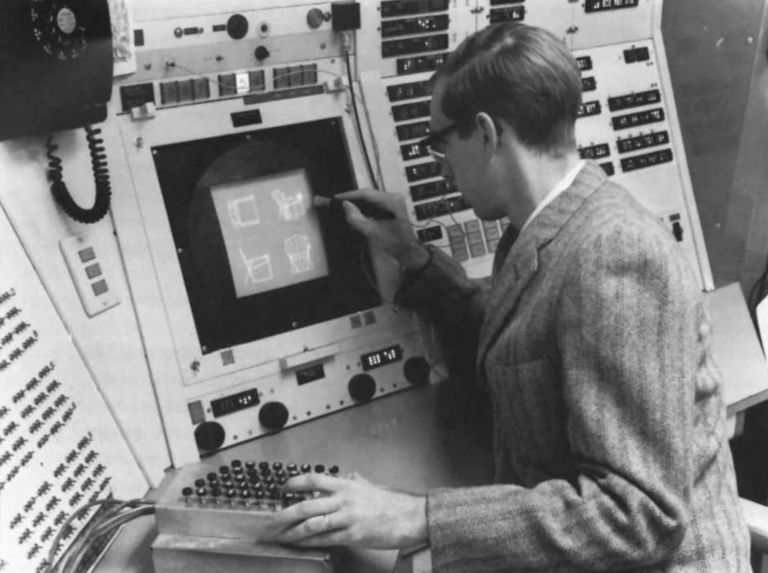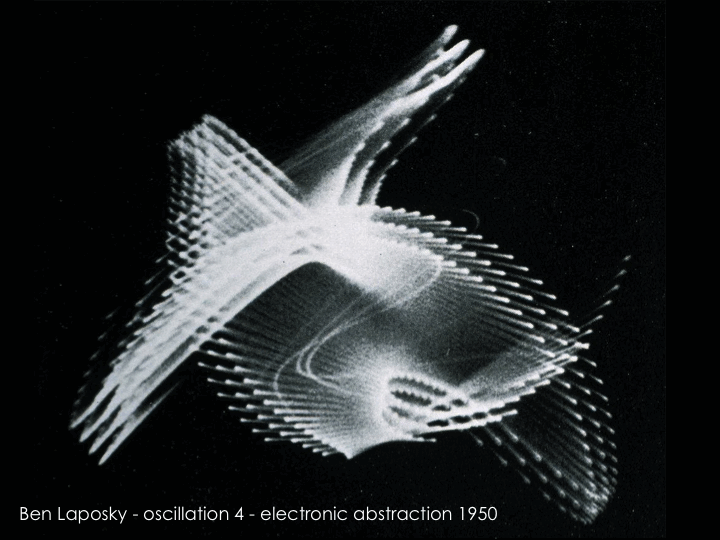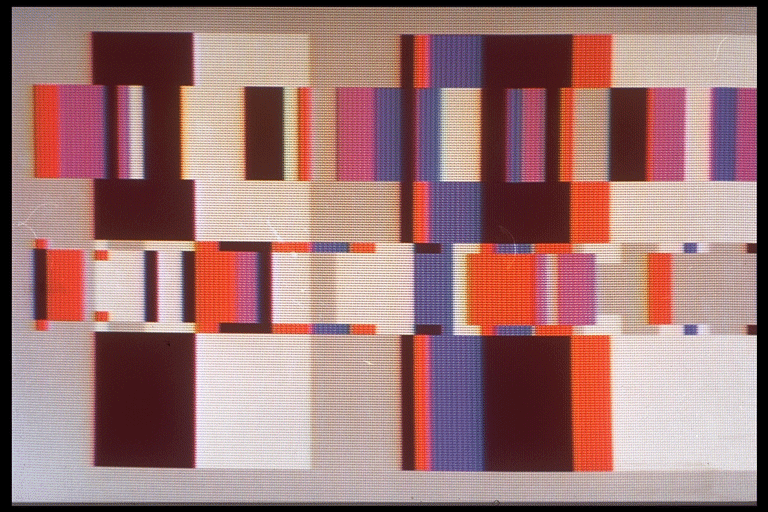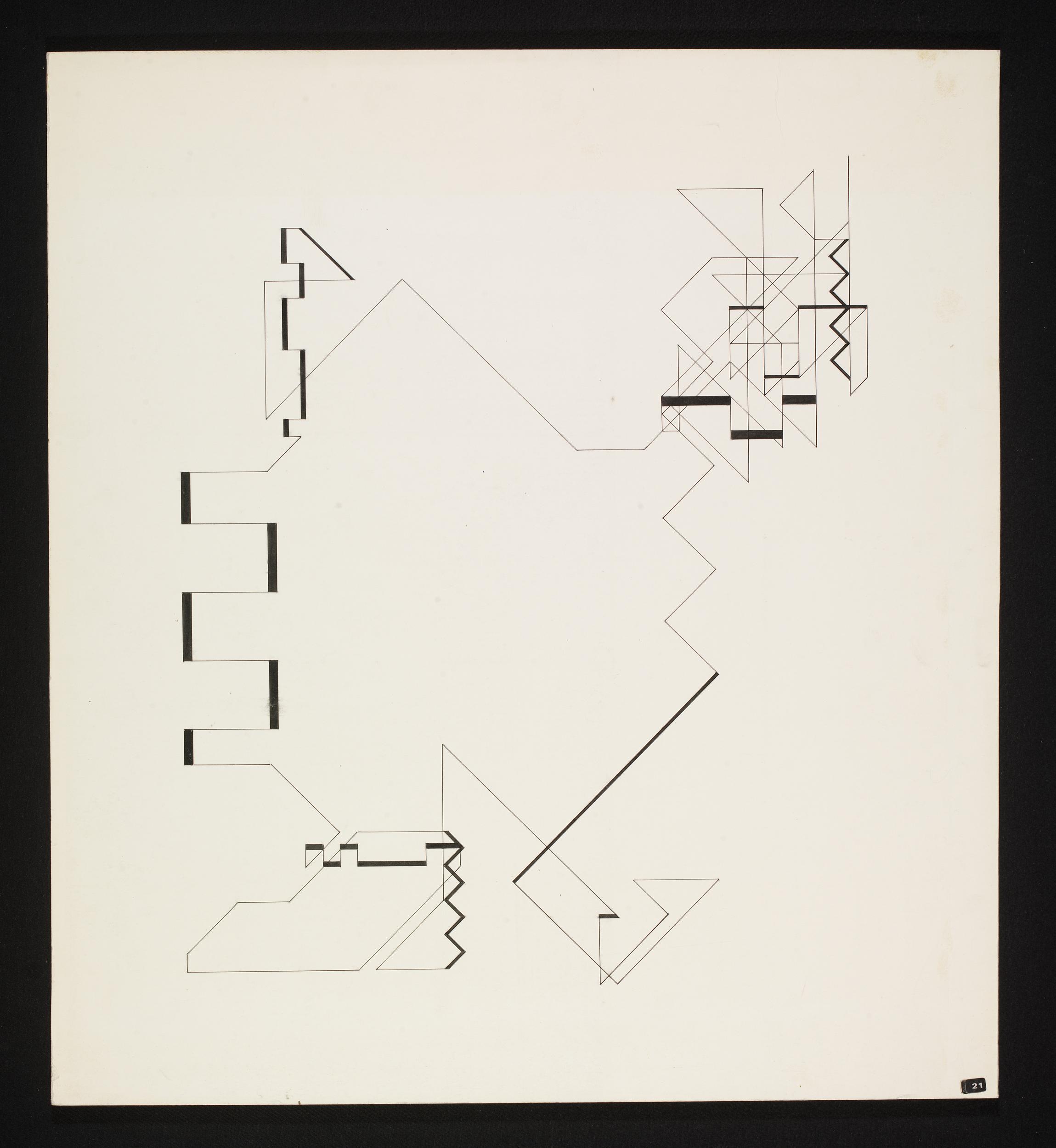

Computational art before computers?
 Tinguely, swiss kinetic sculptor known for the self destructing machine. In the 50s produced a body of work known as metamatics. A parody of American action painting.
Tinguely, swiss kinetic sculptor known for the self destructing machine. In the 50s produced a body of work known as metamatics. A parody of American action painting.


 In the same period matematician and artist Ben Laposky (American from Iowa),made the first computer generated images, photographing the output of an oscilloscope.
In the same period matematician and artist Ben Laposky (American from Iowa),made the first computer generated images, photographing the output of an oscilloscope.

Desmond Paul Henry (British) used bombsight analogue computers which were employed in World War II bombers to calculate the accurate release of bombs onto their target.



These artists seemed to be fascinated by the apparent randomness (unpredictability) of these machines and let them “do their thing”.
On the opposite side of the spectrum there is Sol LeWitt who didn’t use computers but conceived many of his works as a series of instructions. As if they were meant to be created by machines (art gallery interns).

Computer art
 Georg Nees 1965-1968.In the mid-60 computer begin to become relatively more accessible and the first printers (plotters) become available.
Georg Nees 1965-1968.In the mid-60 computer begin to become relatively more accessible and the first printers (plotters) become available. Georg Nees – Schotter 1968.
Georg Nees – Schotter 1968.Nees had to write his own graphics libraries. His works often deals with order vs disorder.
 He also made the world’s first computer-generated sculpture in 1968 using a computer aided milling machines.
He also made the world’s first computer-generated sculpture in 1968 using a computer aided milling machines. Vera Molnar Interruptions-1968-69.
Vera Molnar Interruptions-1968-69.Check this re-code article.The computer art movement was international. Vera Molnar was a French Hungarian artist. Unlike many early computer artists she came from a traditional art background (abstract painting, rebelling against the figurative education she got in Hungary).
 Vera Molnar (Des)Ordres, 1974
Vera Molnar (Des)Ordres, 1974“I have no regrets. My life is squares, triangles, lines” – Vera Molnár
Vera Molnar, Love Story 1974


Vera Molnar. Letters from My Mother 1988
“My mother had a wonderful hand-writing. There was something gothic in it (it was the style of writing of all well-educated ladies in the Habsburg monarchy in the early XXth century) but also something hysteric. The beginning of every line, on the left side, was always regular, severe, gothic and at the end of each line it became more nervous, restless, almost hysteric. As the years passed, the letters in their totality, became more and more chaotic, the gothic aspect disappeared step by step and only the disorder remained.”
Manfred Mohr – P-62 (floating points). German, background in abstract expressionism and jazz.
Offset lithograph on paper from plotter drawing (fine art prints).
 Walk Through Raster, Frieder Nake 1966 (Germany)
Walk Through Raster, Frieder Nake 1966 (Germany) Frieder Nake, Nr. 2 (also known as Hommage to Paul Klee) 1965
Frieder Nake, Nr. 2 (also known as Hommage to Paul Klee) 1965
Herbert W. Franke’s Serie Mondrian (1980), a software created for the Texas Instruments TI 99/4 home computer. Serie Mondrian produced Mondrian-style images according to user defined parameters.


“The anti-computer response came from several sources, both humanist and anti-humanist. The first originated with mainstream critics whose strong humanist tendencies led them to reproach computerised art for its mechanical sterility. A comparison with aesthetically and theoretically similar art forms of the era reveals that the criticism of computer art is motivated by the romantic fear that a computerised surrogate had replaced the artist. Such usurpation undermined some of the keystones of modern Western art, such as notions of artistic “genius” and “creativity”…. Many within the arts viewed the computer as an emblem of rationalisation, a powerful instrument in the overall subordination of the individual to the emerging technocracy.”
Grant David Taylor, “When the Machine Made Art: The Troubled History of Computer Art 1963-1989”

Many of these artists are still around but in the ‘90s computer art morphed into new media art and interactivity and social engagement became the main focus for artists working with technology.
With the democratization of robotics, drawing machines started to get out of the gallery (see graffiti writer) and became more autonomous.

Mechanical Parts by Matthias Dörfelt a robot that draws randomly generated “connectors” aka robot genitals.

Cory Arcangel gradient works are a playful post-modern legacy of computer art.
 Cory ArcangelPhotoshop CS: 110 by 72 inches, 300 DPI, RGB, square pixels, default gradient “Spectrum”, mousedown y=1098 x=1749.9, mouse up y=0 x=4160
Cory ArcangelPhotoshop CS: 110 by 72 inches, 300 DPI, RGB, square pixels, default gradient “Spectrum”, mousedown y=1098 x=1749.9, mouse up y=0 x=4160
Cory ArcangelPhotoshop CS: 110 x 72 inches, 300 DPI, RGB, square pixels, default gradient “Spectrum,” mousedown y=27450 x=6700, mouseup y=4800 x=13400, 2010The preset gradient as pop culture reference that many recognize.
 Cory ArcangelPhotoshop CS: 110 by 72 inches, 300 DPI, RGB, square pixels, default gradient “Spectrum”, mousedown y=1098 x=1749.9, mouse up y=0 x=4160 Low end sloppiness vs high end packaging
Cory ArcangelPhotoshop CS: 110 by 72 inches, 300 DPI, RGB, square pixels, default gradient “Spectrum”, mousedown y=1098 x=1749.9, mouse up y=0 x=4160 Low end sloppiness vs high end packagingAI/Machine learning

AI applied to drawing tools can potentially automate tedious tasks , open new possibilities for human creativity, or perhaps standardize it








